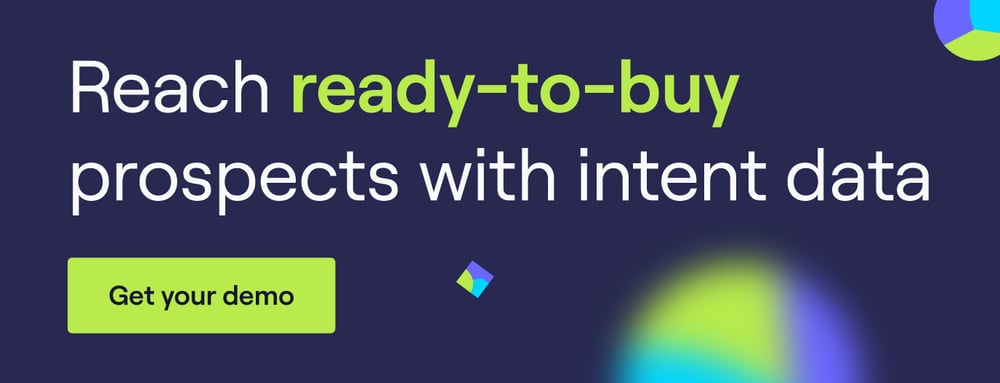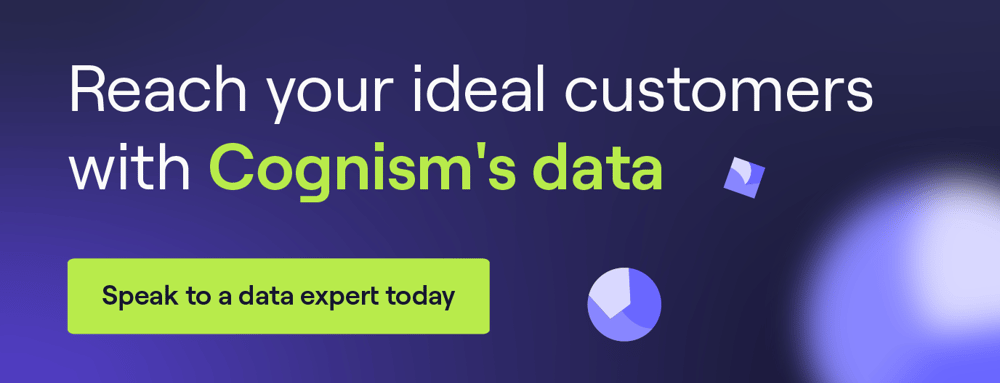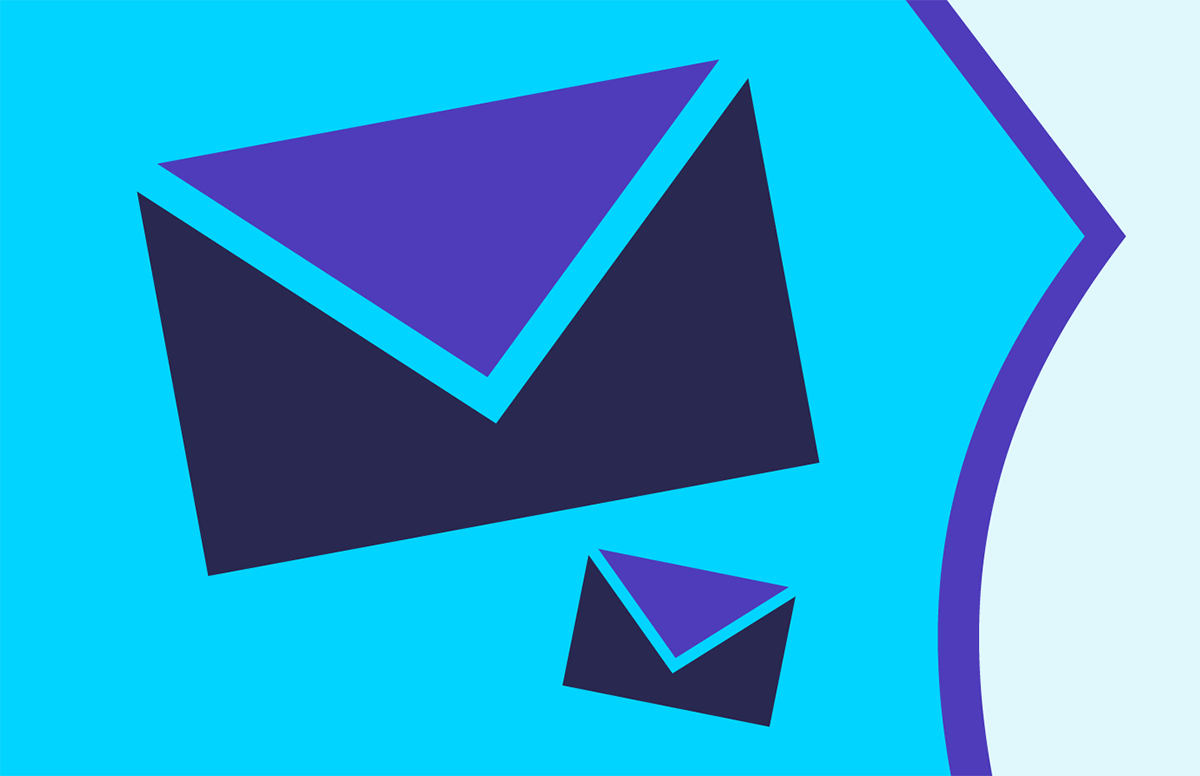Intent Based Marketing: How to Target the Right Leads
Timing is everything, especially in B2B marketing.
And, to get the best quality leads at the right time, you must take an intent based marketing approach.
If you look at the anatomy of a sale, you’ll find two key components — a connection and an action. You need one to create the other, but your chances of getting the desired action diminish greatly if you don’t make the right connection in the first place.
It’s a domino effect: the more targeted you approach a lead, the higher the probability they’ll take action, and the greater your chance of a successful sale.
But how do you find these higher-quality leads? And what makes them higher quality?
That’s what we’ll unpack in this article. Scroll 👇
What is intent based marketing?
Intent based marketing is a strategy that uses customer signals to create tailored buying experiences. You can use sales intelligence tools to help identify and monitor potential customers’ intent and interests.
For instance, if someone’s searching online for “best running shoes for marathons,” it’s pretty clear they’re not a novice runner, and they’re at the researching stage.
Now, imagine you had someone else searching for “best deals for light jogging shoes”; they’re probably a novice runner and are more primed to buy right now.
The intent differs for what they’re looking for and the information they need. So, if you had a sports equipment website, you’d serve two pieces of content to these audiences, even though they’re both looking for running shoes.
Think of Intent based marketing as a B2B company’s digital psychic. It senses what potential customers think, even before they know it themselves. It helps you understand their desires and needs to craft your marketing strategy and align with those signals.
You’re not just guessing; you’re surfing through the data to catch the perfect wave of opportunity.
Keen to learn more about intent data? Watch this video for a quick run-down 👇
Why is intent based marketing important?
When you get a pretty good idea of what a potential customer plans to do, you can tailor your communications to be more relevant and useful. This, in turn, increases the likelihood of a lead becoming a sale.
And intent based marketing is all about tailoring your strategies to match intended actions. Here are four benefits to intent based digital marketing:
- Better ICP targets - you can match intent data signals to criteria to ensure accurate customer target matches. Criteria include revenue, size, background, geography, industry, and technology usage.
- Advertisers can target audiences ready to buy - ad budgets go further when targeting users searching for a similar solution. This practice saves businesses money and boosts ROI.
- Display targeted ads to users who read related articles - programmatic advertising platforms allow marketers to display personalised ads based on users' browsing behaviour.
- Combine intent marketing with ABM for higher revenue - marketers can use data-processing tools to personalise follow-ups and answer prospect’s research questions for more conversions.
Let’s imagine for a second that you’re a guest at a business function or cocktail party.
The event is packed with diverse prospects, all dressed to the nines. Your regular senses give you face-value information about everyone around you.
But what if you had a sixth sense that gave you insight into what each attendee was thinking about?
For example, someone near the snack table starts wondering what the food is like. At that very moment, you swivel around (in a non-Bond villain way!) and mention to them that the crab sticks are best left alone but that the pâté is excellent.
You instantly become a useful ally. You’ve not only broken the ice, but you’ve elevated your trustworthiness and authority in the eyes of your new contact.
Intent based marketing is the digital version of the above scenario. When you can offer helpful information or a solution to something important that your audience is interested in, you tick all the right boxes.
And you’ve caught them in the right mindset and need-state with what feels like a tailored solution, not a sales pitch. Now you’re playing on the same team, moving towards the same goal. It’s a win-win.
How does intent data help your ROI?
The adage “You have to spend money to make money” rings true; however, if you can make smarter use of your spending, you’ll get much more juice from the squeeze.
By being more targeted and timely in your marketing approach, you’ll get higher-quality leads who are more likely to turn into revenue. This is because you won’t be blindly sending marketing messages into the void and hoping something sticks.
When you target leads actively looking for what you’re offering, you’ll experience increased conversions, better engagement, and reduced bounce rates. And with decreased cost per lead, you’re using your marketing budget more efficiently.
The other upshot is that you streamline your efforts, saving precious resources like your time.
How to implement an intent based marketing strategy
Thank goodness for intent data! It’s like having the other team’s playbook; you just need to figure out what strategies will work against each play.
Let’s look at the tactical side of implementing an intent based marketing strategy.
What should you put into your plan?
What little nuggets should you consider?
Keep reading to learn how to take your strategic approach from so-so to go-go 👇
Dive into the data
Go head first from the top springboard with a twist and a somersault 💦
By analysing customer behaviour, preferences, and past interactions, you’ll discover the patterns and insights that point towards customer intention.
By leveraging data from internal and external sources, you can start to decipher the intent of your B2B leads at a personal and enterprise level. The more you know about the historical actions of your target and where they fit in your category’s ecosystem, the better you can personalise the content you put in their digital path.
You can break the data down using different treatments to build a better picture of your audience’s likely intended actions. Your own website’s analytics can already provide you with some golden insights. If you spot a lead who’s visited your pricing pages more than once and a higher than average ‘time on page’…they’re primed to buy!
Use data from both first-party and third-party sources:
- First-party data is the information you collect about users from your own platforms: website, app, CRM system, subscription campaigns, social media, offline surveys, forms, questionnaires, etc.
- Third-party data comes from external websites and platforms: keyword searches, industry blogs, news articles, review sites, etc.
💡 You can use a intent based marketing tool like Cognism or Lusha to gather this data. Look at this workflow to see how these tools can help you find the right contacts at companies searching for your or your competitors’ solutions.
Divide and conquer
Use this marketing data to segment your audience based on their behaviours, interests, and actions.
This will help you to build diverse personas. Then, you can create and serve content that feels custom-made for each persona. Use segmentation to be much more targeted in your communications.
You can also run A/B tests within your segments to see what resonates more with each particular group. You could even hyper-target your audience depending on how far you want to take your segmentation.
For instance, if you wanted to create specific content for visitors attending a particular conference or trade show or tie in campaigns to cold calls.
This is what Ultima did using Cognism:
“I delegate a certain number of companies per week to each rep. This is part of our strategic stack so that we can do sub-campaigns for these specific companies. Intent data allows a salesperson to make the call knowing the prospect’s intent of interest compared to someone who doesn’t know.”
“The reason we use intent data is because we spend about £2 million in marketing per year. However, most of the marketing is driven by our pipeline. The salesperson will identify the opportunities 6-9 months prior. We will then use that data to formulate our campaign programme.”

“Cognism identifies the leads and allows us to target them based on the prospect’s intent. Using intent data has massively reduced our time to engagement.”
By using these intent based marketing services from Cognism, they achieved ROI in 8 weeks.
Tailor your content
Create blog posts, videos, infographics, and social media updates that answer questions, solve problems, and feel tailored to your audience’s needs and curiosities.
Make it fit the context of the searches and mediums your audience has shown intent on. Whatever it is, it should directly address their pain points and aspirations.
Your marketing team will want to work closely with sales to use intent and account based marketing to create the best content for your ideal audience.
An added consideration is to move away from the gated content model. Not only does it create problems like fake email addresses in your database, but it’s a barrier between you and your potential customer.
So, open up your content to everyone! Make it highly useful and position yourself as an industry thought leader.
Take aim with keywords
Your SEO should incorporate carefully selected search terms that align with search engine queries with high intentionality.
Don’t forget to include some long-tail keyword phrases in your keyword strategy. Also, don’t overdo those relevant keywords, or Google 🧐 might think you’re trying too hard.
Instead, use synonyms and make their use feel natural in your copy.
Use tools of the trade
There are loads of intent based marketing tools available to help you sift through the murky waters and discover nuggets of customer intent.
Tools like Google Trends, SEMrush, and Ahrefs can help identify what people are searching for and talking about.
Highly useful third-party data vendors, like Cognism and Bombora, collect quality co-op intent data from over 4,000 high-traffic B2B research websites and domains.
These tools can help you engage with your target businesses on social media platforms and industry forums. Respond to their queries and share valuable insights; show them you’re not just after their business but want to be a partner in their success.
Learn more about Cognism’s intent data for marketing. Watch this video 👇
5 tactical examples of intent based marketing
1. Reach out with a LinkedIn message:
Say you’re a business consultancy, and you’ve pinpointed businesses seeking “digital transformation strategies”. You could craft a LinkedIn message highlighting some of your success stories in this field and invite them to a webinar on mastering digital metamorphosis.
2. Send a link to a blog post:
Imagine you’re in HR software solutions, and a business expresses interest in “employee engagement platforms”. You could send your HR email list a link to a free report on the latest trends in nurturing talent within their industry.
3. Create a comprehensive guide:
Let’s say you’re a cybersecurity company, and you’ve identified businesses searching for “data breach prevention solutions”. You could create a white paper on how to fortify your digital defences and present some case studies of how you successfully combat cyber threats.
4. Email an offer for a demo:
You’re a project management software provider, and a business has been researching “agile project management tools.” Send them an email offering a personalised demo and a downloadable guide to implementing agile methodologies.
5. Publish a video on YouTube:
You could be in logistics software, and you identify businesses researching “warehouse optimisation solutions.” Create a webinar showcasing your software’s ability to streamline inventory management and warehouse operations.
Successful examples of intent based marketing
Now that we’ve laid the groundwork, let’s explore real-world examples of B2B intent based marketing.
Here are five successful intent based marketing examples:
1. Amazon
It may seem uncanny how Amazon often suggests exactly what you were thinking of buying.
It’s all down to their recommendation engine, which analyses your browsing and buying history to make spot-on suggestions. It recognises when your interest is moving toward getting fit; then, it will start serving you recommendations for exercise equipment, fitness books, training supplements, and more.
2. Starbucks
They know your coffee habits better than you do! Their app suggests drinks based on your previous orders, the time of day, and your location. Open the app in the morning, and you’ll probably see a different product offered than if it was evening time.
This personalisation saves their customers time but also reinforces their preferences, which improves loyalty.
3. Netflix
The next series to binge-watch is just a click away, and coincidentally (or not so), it happens to be in the genre you’ve become increasingly interested in.
Netflix uses sophisticated machine learning and artificial intelligence to analyse its user database’s viewing history, preferences, and commonality. It recommends which content would be the most appealing to you.
4. TripAdvisor
Planning a getaway? TripAdvisor knows how to get you into its intent based marketing funnel. It serves up reviews and recommendations that match your travel intent.
It’s like having a well-travelled friend there to tell you about the best places to go. You might be planning a trip to the glorious Scottish Highlands. You start searching “best hikes in Scotland.” Soon after, your social feed contains articles, videos, and ads about exploring the rugged beauty of Scotland.
5. Oracle
A global leader in enterprise software, Oracle taps into intent based marketing to offer solutions that sync with a business’s goals.
For instance, by tracking companies researching ERP systems or database management, they craft useful content demonstrating how their cloud-based offerings solve these specific needs.
Intent based marketing: key takeaways
Intent based marketing isn’t about collecting data — it’s about using B2B data to create meaningful connections with your audience. It’s about predicting their needs and showing up like a helpful friend, ready to guide them toward a solution.
Remember, it’s a marathon, not a sprint. Keep chipping away, and don’t be afraid to test different content ideas to see which resonates better.
By deciphering their intentions, you’re boosting your chances of lead generation success. You’ll also build a loyal following that can’t help but be captivated by your offerings.
So, put your game face on and get cracking with B2B marketing that matches intent!
Better data means better marketing - choose Cognism
Your intent based marketing campaigns are only as good as the data you use.
With Cognism, you can:
- Engage accounts actively searching for your product or service.
- Be there for your buyers when they’re most likely to buy.
- Score and target leads with precision.
Start building more authentic and human connections with Cognism. Book a demo 👇


/SMB%20ABM/Blog_Image_How%20SMBs%20Can%20Run%20Enterprise-Level%20ABM%20on%20a%20Lean%20Budget%20%20Resource%20Card.webp)
/B2B%20marketing%20predictions/b2b-marketing-trends-2026-card.webp)
